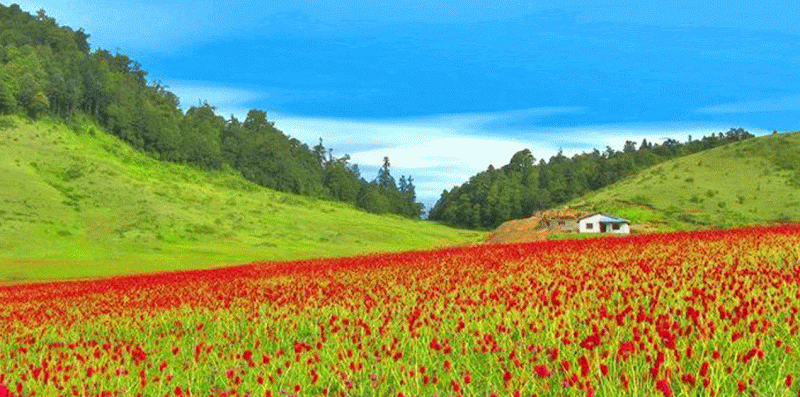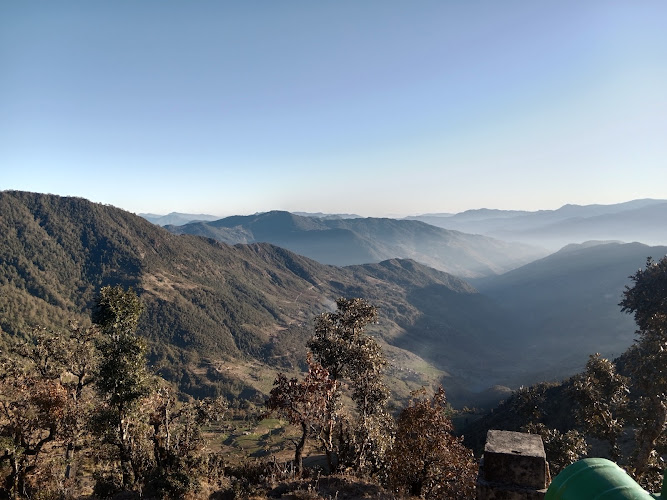


Khaptad National Park - Complete Visitor Guide
10800
In Nepal's far-western hills, where most trekkers never venture and tourist infrastructure remains deliberately minimal, Khaptad National Park preserves 225 square kilometers of high-altitude grasslands, oak forests, and medicinal herb gardens that a wandering mystic transformed into a living laboratory of traditional healing and spiritual practice. Established in 1984 and named for Khaptad Baba, the revered hermit who spent 50 years meditating in these hills before his death in 1996, the park operates on a different wavelength than Nepal's better-known protected areas. This isn't about tigers or rhinos or Himalayan peaks—it's about 224 species of medicinal plants, about sacred ponds and meditation caves, about rolling grasslands called patans where 135 wildflower species bloom each spring in carpets of primulas, buttercups, and wild strawberries that seem transplanted from alpine meadows in Switzerland.
Khaptad Baba, born Swami Sachidananda, arrived in these remote hills in the 1940s seeking isolation for meditation and worship. Over five decades, he identified medicinal plants, treated villagers with herbal remedies, and attracted followers drawn by his reputation for spiritual attainment and healing knowledge. His ashram near the current park headquarters became a pilgrimage site where seekers came for blessings and botanical wisdom. The park's establishment honored his contribution to preserving both spiritual traditions and botanical heritage, creating Nepal's only mid-mountain national park designed explicitly around cultural and medicinal plant conservation rather than wildlife alone.
The landscape rolls across plateaus between 1,400 and 3,200 meters elevation, creating ecosystems distinct from both lowland Terai and high Himalayan zones. Oak forests dominate lower elevations—oak trees with massive trunks and branches draped in moss and epiphytes that create cathedral-like atmospheres. Higher slopes transition to rhododendron stands and then to open grasslands where the absence of tall trees allows 360-degree views across western Nepal's rumpled geography. The park's highest point, Sahashra Linga at 3,200 meters, hosts a sacred site where thousands of stone lingams and natural rock formations inspire devotion among Hindu pilgrims who climb here during festivals.
Religious significance permeates Khaptad beyond Sahashra Linga. The Tribeni confluence where three rivers meet—considered auspicious in Hindu cosmology—marks the approach to park headquarters. A Shiva temple stands nearby, maintained by resident priests who perform daily pujas. Ganesh Temple, Nagdhunga (Snake Spring), and Kedardhunga represent additional pilgrimage destinations scattered across the park, each associated with specific legends and ritual practices. During major festivals like Janai Purnima, hundreds of Hindu devotees trek to Khaptad for ritual bathing and thread-changing ceremonies, temporarily transforming the quiet hills into vibrant religious gathering places.
Wildlife, though not Khaptad's primary draw, includes 23 mammal species adapted to mid-mountain habitats. Leopards prowl forest edges, Himalayan black bears forage for berries and insects, barking deer browse clearings at dawn and dusk, and yellow-throated martens streak through trees with acrobatic agility. The 287 bird species recorded include Nepal's national bird, the iridescent Impeyan pheasant (danphe), along with koklass pheasants, kalij pheasants, and the spectacular satyr tragopan with its crimson plumage and turquoise facial skin. Bird watching peaks during spring migration when Himalayan specialties pass through alongside resident species.
But the medicinal herb garden represents Khaptad's unique treasure. The 224 identified species include plants used in Ayurvedic and traditional Tibetan medicine for millennia—yarsagumba (caterpillar fungus), kutki, jimbu (Himalayan herb), and dozens of others that local healers harvest following sustainable protocols Khaptad Baba helped establish. Spring and early summer bring optimal herb-spotting conditions when plants bloom and identification becomes easier. Botanical researchers and traditional medicine practitioners visit specifically to document species and learn sustainable harvesting techniques that balance conservation with traditional use rights.
Trekking to Khaptad requires determination. From Kathmandu, the journey involves a flight to Dhangadhi in far-western Nepal, then a 100-kilometer, 6-7 hour drive to Silgadhi, followed by a two-day trek to the park. The minimal teahouse infrastructure means carrying camping gear or arranging homestays in villages along the route. This difficulty explains Khaptad's remarkably low visitor numbers—perhaps 2,000-3,000 annually, including both pilgrims and nature tourists. For those who make the journey, the reward isn't wildlife spectacles or mountain vistas but rather the profound quiet of grasslands where wind whispers through sedges, where medicinal herbs grow as they have for millennia, and where a hermit's legacy reminds visitors that some landscapes demand protection not for economic value but for the spiritual and botanical wisdom they preserve.
The park faces challenges from grazing pressures—local communities traditionally used these grasslands for livestock, and negotiating access remains sensitive. Herb poaching tempts collectors seeking high-value medicinal plants for commercial sale. Climate change alters precipitation patterns that affect both grassland ecology and medicinal plant distributions. Yet Khaptad endures as Nepal's most unusual national park, a place where conservation meets traditional medicine and spiritual practice in ways that defy Western conservation models but make perfect sense within Nepal's cultural context.
Park Features & Amenities
♿ Accessibility
- ✓ Wheelchair-accessible car park
- ✓ Wheelchair-accessible entrance
🏃 Activities
- ✓ Hiking
🏗️ Amenities
- ✓ Picnic tables
- ✓ Public toilet
🎠 Children
- ✓ Good for kids
- ✓ Kid-friendly hikes
🐕 Pets
- ✓ Dogs allowed
Visitor Information
🕐 Best Times to Visit
Spring (Mar-May): Pleasant weather, blooming flowers
Autumn (Sep-Nov): Clear skies, comfortable temperatures
Early Morning: Best for wildlife viewing and photography
🗺️ Getting There
By Car: 10800
Public Transport: Local buses and taxis available
Walking: Check distance from city center
💡 Visitor Tips
• Bring water and sun protection
• Wear comfortable walking shoes
• Check weather conditions before visiting
• Bring camera for nature photography
Explore More in Nepal
Nearby Attractions
Popular Activities
Ready to Visit Khaptad National Park?
Plan your visit to this amazing destination with our comprehensive travel guide and insider tips.
Seasonal Travel Guide
Weather & Best Time
Autumn offers the best weather (15-25°C) with clear skies, excellent mountain views, and comfortable temperatures for all activities.
Best Activities:
- Mountain trekking
- Wildlife safaris
- Cultural tours
- Photography expeditions
- Adventure sports
Travel Tips
- Visit during September-November for optimal conditions
- Book early as autumn is the most popular season
- Plan for clear mountain views and excellent trekking
- Enjoy cultural festivals and celebrations
Packing Suggestions:
- Warm layers for cool evenings
- Sturdy hiking boots
- High-quality camera
- Sunglasses and sunscreen
- Comfortable daypack
Quick Facts
Best time: Autumn (Sep-Nov)
Duration: 1-3 days
Difficulty: Easy
Cost: Budget-friendly